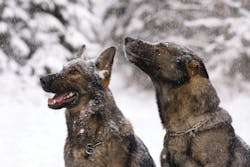Winter is in full swing and hitting some areas of the U.S. pretty hard. Back in July, I wrote the article “Canine Health in the Heat”. Just as with the heat, there are health concerns in the winter months and operational issues.
First thing I would like to address is the canine vehicle. The standard police cruiser is the most widely used among police agencies, but when it comes to canine operations, it isn’t always the best option. For those areas that get any significant amount of snow, I believe a 4-wheel drive SUV is the ideal choice. Having 4-wheel drive allows you to patrol in all weather conditions, within reason of course, year round. Many agencies don’t want to have a canine in a vehicle other than a dedicated canine vehicle. I can understand that; why have the canine tearing up a non-canine vehicle, getting hair all over it, and not equipped for the canine?
As we all know, a canine vehicle generally has some special equipment installed, such as the canine containment unit, heating/cooling systems, remote door popper/opener, and the ever present “Caution K9” stickers. So what happens in the winter, when you have that 2-wheel drive sedan that won’t make it out in the conditions? Change vehicles; sure if you’re not canine, you get into an SUV. No such luck if you’re canine, unless you leave your four-legged partner behind. Yes that is an option, but then you don’t have the option of using that canine if something happens.
Just because it is snowing a few inches an hour, doesn’t mean crime stops. If this is your situation, then there should at a minimum be a crate in the station for the canine to be in while you are on patrol. I was recently talking to an officer from another agency, who stated that during a recent snow storm, their canine officer left the canine in the police car without the engine running and of course no heat, and went on patrol in a 4-wheel drive SUV. How accurate that is I don’t know, but if true, I see that as abuse of the canine. During the winter, a vehicle is much like a refrigerator, holding in the cold, and can lead to that canine freezing to death. If there is no crate in the station, or a climate controlled kennel, then at a minimum, the vehicle should have had the engine running, with the heat on, but not to a degree of overheating the canine, and doors locked. Another option would have been to leave the canine at home. I will say it again: a 4-wheel drive SUV is the ideal choice for canine year round.
Winter brings on other issues that I will now discuss. Not all canines are cut out for the cold, especially extreme cold. Most working canines with long hair don’t have much of a problem because of the double coat. Short haired canines will have more of a problem and probably won’t be able to operate for nearly as long as a long haired canine. Imagine working in 20 degree weather without your winter coat on. That’s how it is for short haired canines. Keep that in mind.
When you bring your partner inside out of the elements, wipe down their stomach, legs and especially their feet. This will help warm them up by removing the snow, ice and sleet. This also removes potentially dangerous chemicals that they may lick off themselves. When wiping them down, check for any snow and encrusted ice on their pads/feet that could lead to cracking and bleeding pads. Many years ago I did try out the canine booties, but didn’t care for them; neither did my canine. They are an option, but that is something that you should try out and implement during training. If you decide to just put them on your canine one day, they won’t know what to think about it and may spend the shift trying to remove them.
A lot of activities during the winter tend to take more energy to accomplish. In order to have and maintain that energy, we need to nourish ourselves and our canines. This may also require increasing the amount that canine eats, more specifically their protein intake. This will keep your canine and their fur in good health and ready for anything Mother Nature may throw at us.
When it comes to bathing, it’s just a little more work during the winter. Bathe your partner as usual, but then thoroughly towel-dry him/her. If necessary, use a hair dryer on low heat, and keep it away from their nose and ears. You wouldn’t take a shower and then walk out into the freezing weather all wet would you? Don’t do that to your partner.
Just as you would any other time of year, maintain your equipment. Frequently inspect all your leads, harnesses and collars for damage. If a piece of equipment is overly worn or damaged, take it out of service if necessary and replace it. If it is still serviceable, then clean it according to manufacturer’s guidelines. I’m not a fan of nylon leads or collars, especially during winter months. They soak up moisture and freeze. This is not comfortable for your canine and makes the leads less workable. I prefer leather leads; although they may stiffen up from the cold, they will still be flexible.
One last tip that everyone should do for the protection of all small animals. As you approach your vehicle, look for paw prints. Many small animals, whether they be cats, skunks, etc, will be looking for a warm place to hide from the elements. The engine puts off a lot of heat for a while after it is shut off, so it isn’t uncommon for a small animal to sleep in the engine compartment of a vehicle. If you see paw prints, make some noise, bang on the hood to scare them away, and if necessary, open the hood and check for any animals. Just be warned, it could be a skunk, so don’t get sprayed.
Have a warm and healthy winter.
Stay Safe!

Steven Forgues
Steve Forgues started his career over 18 years ago in Arizona. Over the years, Forgues has worked contract security, police, corrections and tactical operations. Forgues has been an instructor in various disciplines since 1998, and has been working and training with canines since 2000. Forgues has also been writing for law enforcement since 2005. He is currently working as a police officer and firefighter in Pennsylvania.



